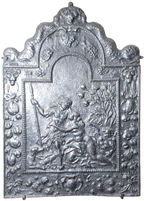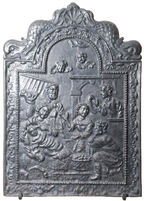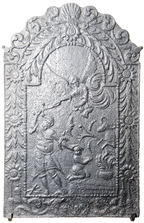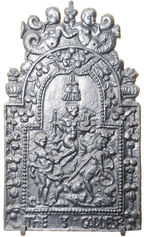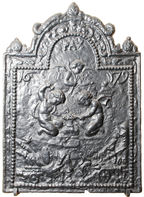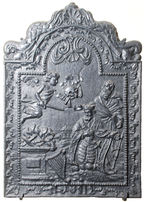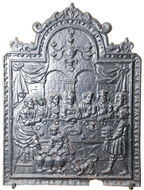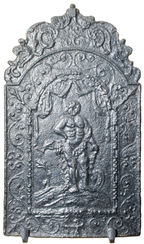-
557
Description: Arched rectangular central panel with bead edging; pictorial scene of Venus, naked and kneeling, and Adonis, standing, holding a spear in his left hand, with Cupid to the left, and a hound and a quiver of arrows below to the right; arched rectangular border with fillet edging; at top of arch, grape bunches; at each side, a festoon of fruit suspended on a ribbon from a lion's head; at the bottom, an oval cartouche between flowers; on top, an urn from which descends a dolphin on each side of the arch.
Notes: The scene is based on the painting (c.1635) of Venus and Adonis by Peter Paul Rubens; the same central panel is known with several different borders. Mitford collection, Petworth House.
Copies of this fireback are known.
- Decoration tags:
- 'Dutch' (shape)
- fillet (edging)
- whole carved pattern
- pictorial
- mythological
- humans
Manufactured: in the mid- to late-17th century in the Siegerland area of Germany.
Current location: Petworth House, Petworth, West Sussex, England.
Museum number: NT/PET/M/49 (part of the National Trust museum group)
- Attached to series:
- 'Dutch' Miscellaneous Firebacks
- 'Dutch' Venus and Adonis firebacks
-
558
Description: Arched rectangular shape; fillet edging; top centre, stamp formed of a carved domestic scene of a family around a table; in top corners, repeated small stamp of St George and the Dragon; below, repeated stamp of a pineapple in a pot; centre; small stamp of the royal arms of the United Kingdom 1801-37.
Notes: The domestic group has been formed from a decorative iron mantelpiece ornament portraying the tale of the goose that laid golden eggs. Having killed the goose, the family are lamenting the loss of their bounty (see Ames, 1980, p.94). The same mantelpiece group and pineapple stamp can be seen as decoration on the kitchen spit assemblage at Petworth House, West Sussex, which was cast at Robert Chorley's foundry at Cocking, south of Midhurst. Evidently this and another fireback bearing the same ornament stamp were among items from the Cowdray estate sold in 1898. Mitford collection, Petworth House.
Arms: Royal arms of the United Kingdom 1801-37
- Decoration tags:
- rectangular with round arch (shape)
- fillet (edging)
- carved stamps
- armorial
- royal
- animals
- humans
- plants
Manufactured: in the early-19th century probably at Cocking Foundry in the Weald area of England.
Current location: Petworth House, Petworth, West Sussex, England.
Museum number: NT/PET/M/50 (part of the National Trust museum group)
Citation: Ames, A., 1980, Collecting Cast Iron (Ashbourne, Moorland Publishing).
- Attached to series:
- Cocking foundry firebacks
- Ornament stamp firebacks
- Metalware stamp firebacks
-
571
Description: Arched rectangular shaped central panel with bead-on-fillet edging; pictorial scene of the interior of the stable at Bethlehem with a stone arched doorway and a hay stall in the background; in the left foreground the seated figure of the Virgin Mary with the infant Jesus, and Joseph behind; behind Joseph a donkey, and to the left of the child a seated ox; to the right, three figures, one kneeling and another holding a hat; in front of the kneeling figure a basket; arched rectangular border with fillet edging and a repeated leaf pattern; on top, a scallop shell between two dolphins.
Notes: The scene is of the Adoration by the Magi - Matthew 2: 11. Mitford collection, Petworth House.
Copies of this fireback are known.
Manufactured: in the mid- to late-17th century in the Siegerland area of Germany.
Current location: Petworth House, Petworth, West Sussex, England.
Museum number: NT/PET/M/62 (part of the National Trust museum group)
- Attached to series:
- 'Dutch' Miscellaneous Firebacks
- New Testament firebacks
- 'Dutch' Dolphin series
-
577
Description: Arched rectangular central panel with bead-and-pellet edging; pictorial scene of Abraham about to sacrifice Isaac, the former's hand being stayed by an angel, a ram in an adjacent thicket; arched rectangular border with fillet edging; arrangement of sunflowers linked with festoons of leaves; at bottom, swirled foliage; on top, a scallop shell between mirrored swirled foliage.
Notes: The scene is from the Old Testament - Genesis 22: 12; a popular subject on firebacks. Mitford collection, Petworth House.
Manufactured: in the mid- to late-17th century possibly in the Siegerland area of Germany.
Current location: Petworth House, Petworth, West Sussex, England.
Museum number: NT/PET/M/68 (part of the National Trust museum group)
-
520
Description: Arched rectangular central panel with bead edging; with tassel at top; three nude female figures: on top, Juno/Hera with a peacock, to the left Venus/Aphrodite, the young cupid/Eros at her feet, to the right Minerva/Athena with spear and shield; arched rectangular border with fillet edging; the heads of two putti and from them two suspended festoons of fruit and leaves; at the bottom, the inscription, THE 3 GODDESES, widely spaced. On top, two figures of Triton blowing seashells. On each shoulder of the fireback, a fluted vase with flowers issuing.
Notes: The three eponymous goddesses are those whose beauty was the subject of the Judgement of Paris. The composition is copied from an engraving by Adriaen Collaert (c1560-1618). This fireback is an instance of a continental back which has been recast in England, the opportunity being taken to insert an English inscription in place of the customary date and pattern maker's monogram. Mitford collection, Petworth House.
Copies of this fireback are known.
Inscription: THE 3 GODDESES [sic]
- Decoration tags:
- 'Dutch' (shape)
- fillet (edging)
- whole carved pattern
- planklines
- pictorial
- mythological
- text
Manufactured: in the late-17th century in England.
Current location: Petworth House, Petworth, West Sussex, England.
Museum number: NT/PET/M/74 (part of the National Trust museum group)
- Attached to series:
- 'Dutch' NDW series
- Judgement of Paris firebacks
-
521
Description: Rectangular with arched, mirrored scrolls on top and central scallop shell; fillet edging; Pan, with a goat behind, trees to left and right; a putto above right; at the bottom, a separate rectangular panel with mirrored scrolled foliage.
Notes: A scene apparently unrelated to a specific classical narrative, and without the customary decorated border. Mitford collection, Petworth House.
Copies of this fireback are known.
- Decoration tags:
- rectangular with ornate arch (shape)
- fillet (edging)
- whole carved pattern
- pictorial
- mythological
- animals
- humans
- plants
Manufactured: in the early-18th century in England.
Current location: Petworth House, Petworth, West Sussex, England.
Museum number: NT/PET/M/75 (part of the National Trust museum group)
- Attached to series:
- Late pictorial series (all)
- Late pictorial series 2
-
525
Description: Arched rectangular central panel with bead edging; pictorial scene of two putti bent over a central anvil, with a third putto above; below are martial symbols (cannon, banners etc.); in the arch the word 'PAX', and in the shoulders of the panel, the date in two parts; arched rectangular boreder with fillet edging, and foliage draped from the top; on top, a pomegranate to which ascends a serpent on each side, with a further pomegranate on each shoulder of the plate.
Notes: The scene may be intended to represent the infant Vulcan. Mitford collection, Petworth House.
Inscription: PAX / 16 79
- Decoration tags:
- 'Dutch' (shape)
- fillet (edging)
- whole carved pattern
- individual numbers
- pictorial
- mythological
- text
- humans
- objects
Manufactured: in 1679 possibly in the Siegerland area of Germany.
Current location: Petworth House, Petworth, West Sussex, England.
Museum number: NT/PET/M/79 (part of the National Trust museum group)
- Attached to series:
- 'Dutch' Miscellaneous Firebacks
-
527
Description: Arched rectangular central panel with bead edging terminating at the top in two loops, gather drapery and a scallop shell; two figures to the right, both bearded, the one kneeling wears cavalry armour, a cloak and a crown, the other stands behind; to the left is a sacrificial pyre on which an ox carcass burns, and above an angel carrying a sword in his right hand and a skull in his left; around this is an arched rectangular border with fillet edging and a repeated leaf pattern; on top is a scallop shell between two dolphins.
Notes: The scene illustrates the visitation of the pestilence on Israel described in 2 Samuel 24, and the sacrifice of an oxen by King David; the skull borne by the angel represents the death of those struck down by the plague. A slightly different version has the face of David looking up at the angel (no. 424). Mitford collection, Petworth House.
Copies of this fireback are known.
Manufactured: in the mid- to late-17th century in the Siegerland area of Germany.
Current location: Petworth House, Petworth, West Sussex, England.
Museum number: NT/PET/M/81 (part of the National Trust museum group)
-
528
Description: Arched rectangular central panel with bead edging; pictorial scene of seven figures, the central one crowned, seated at a table laid with cups and dishes, with two other figures, one at the front, the other to the right, serving them; below are martial symbols (cannon, banners etc.); behind the figures are two archways with drapery at the side, and a chandelier above; arched rectangular border with fillet edging, and egg-and-dart moulding on top and sides; on top, a diamond within a cartouche, and the same on each shoulder of the plate; descending from the top, a serpent on each side.
Notes: The scene is of the marriage at Cana (John 2), a biblical story often portrayed on firebacks and stoveplates. Mitford collection, Petworth House.
- Decoration tags:
- 'Dutch' (shape)
- fillet (edging)
- whole carved pattern
- pictorial
- biblical
- architectural
- humans
Manufactured: in the mid- to late-17th century in the Siegerland area of Germany.
Current location: Petworth House, Petworth, West Sussex, England.
Museum number: NT/PET/M/82 (part of the National Trust museum group)
- Attached to series:
- 'Dutch' Miscellaneous Firebacks
- New Testament firebacks
-
537
Description: Arched rectangular central panel with bead-and-pellet edging on a broad fillet; nude figure of a man standing on a mound, resting his left hand on a club, a plant to his right, and drapery swags above; arched rectangular border with symmetrical swirls; monogram centre bottom; on top, symmetrical, swirled foliage.
Notes: The figure is probably of Hercules. The depiction may have been adapted from the image of the divine hero in 'Speculum Romanae Magnificentiae', a collection of engravings dated 1573 by Antonio Lafreri after Philippe Thomassin. Mitford collection, Petworth House.
Copies of this fireback are known.
Inscription: SHR
- Decoration tags:
- 'Dutch' (shape)
- fillet (edging)
- whole carved pattern
- pictorial
- mythological
- monogram
- text
- humans
Manufactured: in the late-17th to early-18th century in England.
Current location: Petworth House, Petworth, West Sussex, England.
Museum number: NT/PET/M/91 (part of the National Trust museum group)
- Attached to series:
- SHR series
- British 'Dutch' style firebacks
